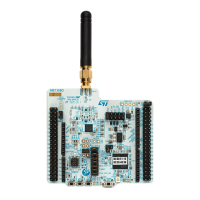RM0453 Rev 5 991/1450
RM0453 Real-time clock (RTC)
1048
32.3.2 RTC pins and internal signals
RTC_OUT1 and RTC_OUT2 select one of the following two outputs:
– CALIB: 512 Hz or 1 Hz clock output (with an LSE frequency of 32.768 kHz). This
output is enabled by setting the COE bit in the RTC_CR register.
– TAMPALRM: This output is the OR between TAMP and ALARM outputs.
ALARM is enabled by configuring the OSEL[1:0] bits in the RTC_CR register which select
the alarm A, alarm B or wake-up outputs. TAMP is enabled by setting the TAMPOE bit in the
RTC_CR register which selects the tamper event outputs.
The RTC kernel clock is usually the LSE at 32.768 kHz although it is possible to select other
clock sources in the RCC (refer to RCC for more details). Some functions are not available
in some low-power modes or V
BAT
when the selected clock is not LSE. Refer to
Section 32.4: RTC low-power modes for more details.
Table 207. RTC input/output pins
Pin name Signal type Description
RTC_TS Input RTC timestamp input
RTC_REFIN Input RTC 50 or 60 Hz reference clock input
RTC_OUT1 Output RTC output 1
RTC_OUT2 Output RTC output 2
Table 208. RTC internal input/output signals
Internal signal name Signal type Description
rtc_ker_ck Input RTC kernel clock, also named RTCCLK in this document
rtc_pclk Input RTC APB clock
rtc_its Input RTC internal timestamp event
rtc_tamp_evt Input
Tamper event (internal or external) detected in TAMP
peripheral
rtc_it Output
RTC interrupts (refer to Section 32.5: RTC interrupts for
details)
rtc_alra_trg Output RTC alarm A event detection trigger
rtc_alrb_trg Output RTC alarm B event detection trigger
rtc_wut_trg Output RTC wake-up timer event detection trigger
rtc_calovf Output
RTC calendar overflow: this signal is generated when the
RTC calendar reaches its maximum value, on the 31
st
of
December 99, at 23:59:59. The calendar is then frozen and
cannot overflow.

